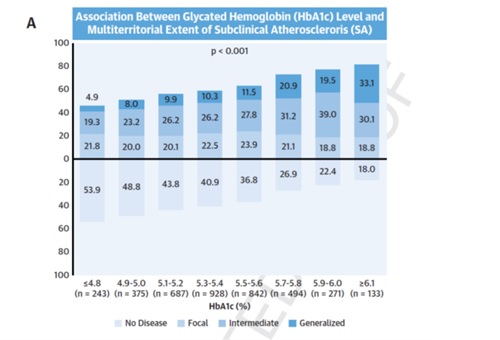JACC: A blood sugar biomarker identifies patients with atherosclerosis and a risk of cardiovascular events
In an article published in JACC, CNIC scientists report a method for improved ranking of cardiovascular risk in individuals without diabetes
The routine use of the glycosylated hemoglobin test to track blood sugar levels in the general population can identify individuals with more advanced atherosclerotic disease. Currently used in the diagnosis and management of diabetes, glycosylated hemoglobin can provide a useful estimate of atherosclerotic disease, and therefore of cardiovascular risk, in individuals without diabetes with or without possible prediabetes. This is the main finding of a study carried out by scientists at the Centro Nacional de Investigaciones Cardiovasculares (CNIC).
The advance heralded by the CNIC study is the use of this blood-sugar measure in apparently healthy middle-aged individuals who do not have diabetes mellitus but with or without possible prediabetes.
When used in combination with traditional risk factors (hypertension, dyslipidemia, and smoking), the glycosylated hemoglobin test more accurately distinguishes between people at high and low risk of atherosclerotic disease.
The study, published in The Journal of American College of Cardiology (JACC), proposes that, because glycosylated hemoglobin levels can easily be reduced through lifestyle changes, the test should be at the front line of risk reduction strategies
The glycosylated hemoglobin diagnostic test is cheap, accessible, and widely used in daily clinical practice, explained Dr. Xavier Rosselló, CNIC scientist and cardiologist at Hospital Universitario Son Espases in Palma de Mallorca. The test can therefore be put to immediate use to calculate the degree of subclinical atherosclerosis in the general population.
According to CNIC General Director Dr. Valentín Fuster, this new information “will help to provide a more personalized assessment of cardiovascular risk at almost no additional cost, paving the way to personalized treatment plans principally focused on lifestyle changes, followed when necessary by treatment with antidiabetic drugs.”
The study forms part of the collaborative PESA-CNIC-SANTANDER project, which is led by Dr. Fuster. Begun in 2010 and recently extended until 2030, the PESA-CNIC-SANTANDER study is one of the most important cardiovascular prevention studies in the world.
Atherosclerosis is usually only detected at advanced stages, after it has already triggered a cardiovascular event such as a myocardial infarction or stroke. Events of this type severely worsen patient prognosis, and the early detection of ather
The new CNIC finding provides a simple way to increase the accuracy of cardiovascular risk ranking in individuals without diabetes with or without prediabetes
According to Dr. Rosselló, “the glycosylated hemoglobin test was especially useful in identifying subclinical disease in participants classified at low risk according to traditional scores; it made less of a contribution to risk calculation for individuals who already had a moderate level risk according to other risk factors.”
The authors conclude that “this study establishes glycosylated hemoglobin as a mass-use biomarker because its greatest benefit is in individuals at low cardiovascular risk, who form the immense majority of the general population and account for most cardiovascular deaths in absolute terms.”
The study was conducted by a multidisciplinary team that included physicians, biologists, statisticians, bioinformaticians, nurses, and many other professionals who, with together with the Banco Santander employees who make up the study population, make the PESA study possible.
The study was funded by the Instituto de Salud Carlos III (ISCIII, PI15/ 02019, PI17/00590, PI20/00819) and the European Regional Development Fund (ERDF) “A way to make Europe” and included scientists from the CIBER de Enfermedades CardioVasculares (CiberCV) research networ
- Glycated hemoglobin and subclinical atherosclerosis in people without diabetes. Xavier Rossello, Sergio Raposeiras-Roubín, Belen Oliva, Fatima sanchez-cabo, José Manuel García-Ruiz, Francisca Caimari, Jose M Mendiguren, Enrique Lara Pezzi, Hector Bueno, Leticia Fernandez-Friera, Antonio Fernández-Ortiz, Javier Sanz, Borja Ibañez, and Valentin Fuster. 10.1016/j.jacc.2021.03.335











